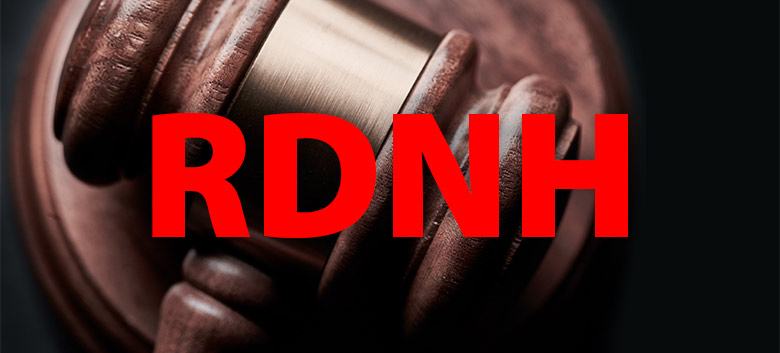The UDRP filed against the domain Soskin.com ended with a finding of Reverse Domain Name Hijacking — an easy decision, as the Respondent’s last name is Soskin.
The Complainant is Cosmetic Research Group, France, who claimed rights to the SOSKIN mark in France since 1992. Too bad, said the Respondent Mr. Robert Soskin, who owns rights to the last name …since his birth:
The Respondent does not dispute that the Complainant has rights in the trademark SOSKIN, adding that the disputed domain name represents the Respondent’s surname. The Respondent states that it registered the disputed domain name on its original registration date for personal and family email purposes, with various of its family members using a corresponding email address across some 27 years, all of whom share the “Soskin” last name. The Respondent contends that it has been and is commonly known thereby, adding that it makes a legitimate noncommercial use of the disputed domain name without any intent for commercial gain or misleadingly to divert consumers.
This part led to the RDNH finding:
The Respondent submits that the Complainant is and has been aware that no registration or use in bad faith has occurred, and that the maintenance of the disputed domain name for 27 years indicates a legitimate interest and good faith. The Respondent notes that the Complainant filed the Complaint without reaching out to the Respondent while fully aware of its good faith.
Final decision: Deny the transfer of the domain Soskin.com to the French Complainant with a finding of Reverse Domain Name Hijacking.

Copyright © 2025 DomainGang.com · All Rights Reserved.ARBITRATION AND MEDIATION CENTER
ADMINISTRATIVE PANEL DECISION
Cosmetic Research Group v. Robert Soskin
Case No. D2025-07841. The Parties
The Complainant is Cosmetic Research Group, France, represented by Novagraaf France, France.
The Respondent is Robert Soskin, United States of America (“United States”), represented by Westman, Champlin & Koehler, P.A., United States.
2. The Domain Name and Registrar
The disputed domain name soskin.com is registered with Network Solutions, LLC (the “Registrar”).
3. Procedural History
The Complaint was filed with the WIPO Arbitration and Mediation Center (the “Center”) on February 25, 2025. On February 26, 2025, the Center transmitted by email to the Registrar a request for registrar verification in connection with the disputed domain name. On February 26, 2025, the Registrar transmitted by email to the Center its verification response disclosing registrant and contact information for the disputed domain name which differed from the named Respondent (“X”) and contact information in the Complaint. The Center sent an email communication to the Complainant on March 5, 2025, providing the registrant and contact information disclosed by the Registrar, and inviting the Complainant to submit an amendment to the Complaint. The Complainant filed an amended Complaint on March 7, 2025.
The Center verified that the Complaint together with the amended Complaint satisfied the formal requirements of the Uniform Domain Name Dispute Resolution Policy (the “Policy” or “UDRP”), the Rules for Uniform Domain Name Dispute Resolution Policy (the “Rules”), and the WIPO Supplemental Rules for Uniform Domain Name Dispute Resolution Policy (the “Supplemental Rules”).
In accordance with the Rules, paragraphs 2 and 4, the Center formally notified the Respondent of the Complaint, and the proceedings commenced on March 10, 2025. In accordance with the Rules, paragraph 5, the due date for Response was March 30, 2025. The Response was filed with the Center on March 27, 2025.
The Center appointed Andrew D. S. Lothian as the sole panelist in this matter on April 2, 2025. The Panel finds that it was properly constituted. The Panel has submitted the Statement of Acceptance and Declaration of Impartiality and Independence, as required by the Center to ensure compliance with the Rules, paragraph 7.
4. Factual Background
The Complainant is a French simplified joint stock company (Societe par actions simplifiee). According to the translation of its corporate registration entry, its main activities are manufacturing, purchasing, selling, importing, exporting, cosmetic products, training professional studies, and advice.
The Complainant has a range of trademarks for the mark SOSKIN. Several of these predate the Respondent’s registration of the disputed domain name, including, for example:
French Registered Trademark Number 92434601 for the word mark (Marque verbale) SOSKIN, filed on September 21, 1992, in Classes 3, 5, and 44; and International Registered Trademark Number 614748 for the figurative mark SOSKIN, filed on March 7, 1994, in Classes 3, 5, and 42, in respect of which protection has been granted in some 29 territories, not including the United States, where the Respondent is based.
The Complainant is also the owner of United States Registered Trademark Number 3200020 for the word mark SOSKIN, registered on January 23, 2007, in Class 3, with a claimed first use and use in commerce dated April 2003. Said mark postdates the registration date of the disputed domain name.
The Complainant provided a list of what appears to be an extensive portfolio consisting of some 80 SOSKIN-formative trademarks registered in a wide variety of territories worldwide.
The Complainant appears to use the domain name soskin.fr, registered on July 14, 2003.
According to RDAP records, the disputed domain name was registered on January 30, 1998. The Respondent is a private individual based in the United States. The Respondent’s age range is given in an online public database (a copy of which was produced by the Respondent). This age range predates the Complainant’s trademark registrations. The Panel has no reason to believe that the Respondent has not borne the surname “Soskin” since birth. As the contrary has not been demonstrated, the Panel also proceeds on the basis that the Respondent is the original registrant of the disputed domain name.
According to the Complainant’s screenshot dated February 3, 2025, the website associated with the disputed domain name is an “under construction” page provided by the Registrar, which features “Relevant searches” (“Recherches pertinentes”) consisting of three sponsored advertising links for “Facial Care” (“Soin Visage”), “Skin Creme” (“Skin Cream”), and “Face Serum” (“Serum Visage”). These appear to relate to the Complainant’s line of business, and also to be geo-targeted, given that they are in the French language.
Accordingly, the Panel visited the website associated with the disputed domain name on April 6, 2025 from its own location in the United Kingdom and noted that the page featured different sponsored advertising links from those observed by the Complainant, which are nevertheless related to the Complainant’s line of business, namely “Skin Creme”, “Facial Creme”, and “Soothing Skin Care”. On the Panel conducting its own research in this way, see the WIPO Overview of WIPO Panel Views on Selected UDRP Questions, Third Edition, (“WIPO Overview 3.0”), section 4.8.
The Respondent produces a screenshot of the website associated with the disputed domain name taken by the Internet Archive “Wayback Machine” dated December 24, 2023, which features a similar page provided by the Registrar, although the advertising links are “Accident Lawyers”, “Parental Control”, “10 Best Mutual Funds”, “Health Insurance”, and “Migraine Pain Relief”. These do not appear to be directly related to the Complainant’s line of business, and, given the location of the “Wayback Machine”, may have been geo-targeted to the United States.
The Respondent produces two similar archived entries for the website associated with the disputed domain name dated October 30, 2011, and November 29, 2011, respectively, showing a page titled “Soskin Family Update” which is described as “[…] our home for info, photos, videos, calendars and blogging, all to help us stay connected. We have family miles apart […]”.The Respondent shows, with reference to a screenshot from its domain name configuration control panel, that the disputed domain name is configured for use by it and others for email addresses. The Respondent also shows, with reference to the Registrar’s control panel, that it has configured no web services for the disputed domain name.
The Complainant shows, with reference to a series of Google searches geo-targeted to France, the United States, and the United Kingdom, that it and its products have a substantial reputation. These searches also supported the surname connotation of the term, although not specifically referring to the Respondent.
5. Parties’ Contentions
A. Complainant
The Complainant contends that it has satisfied each of the elements required under the Policy for a transfer of the disputed domain name.
Notably, the Complainant contends that Internet users will think that the disputed domain name belongs to the Complainant because of its identity with the Complainant’s mark. The Complainant notes that the Respondent holds no trademarks in the mark SOSKIN and adds that the website associated with the disputed domain name features links to websites offering cosmetic creams and skincare products that compete with the Complainant’s mark, which use does not represent a bona fide offering of goods or services and does not establish rights or legitimate interests under the Policy.
With reference to the anticipated claim that the Respondent may make that it has been commonly known by the disputed domain name, the Complainant notes that the Respondent has the family name “Soskin”, and cites SBC Communications Inc. v. Fred Bell aka Bell Internet, WIPO Case No. D2001-0602, in which an individual claiming to possess the name “Fred Bell” was held not to be commonly known by the domain names bellinternet.com and bell-net.com. The Complainant notes that it was also held to be relevant that the respondent in that case used the domain names concerned to direct Internet users to websites that bore no relation to his family name and were designed to cause Internet user confusion regarding an association between the complainant and respondent. Said websites latterly featured a solicitation to persons interested in exploiting e-commerce opportunities. The panel in that case noted that the respondent’s family name was not, prior to the registration of the domain names concerned, associated with the business of providing such services.
The Complainant also cites Association des Centres Distributeurs E. Leclerc – A.C.D Lee v. Daniel Leclerc, WIPO Case No. D2012-1685, in which the respondent bore the surname “Leclerc”, corresponding to the complainant’s LECLERC trademark, and the domain names concerned were leclerc-products.com and leclerc-products.net. In that case, the panel found that the respondent would have been entitled to exercise an economic activity under its name but had not established that it had made itself known to the public for economic activities unrelated to the complainant’s field, and had not specified what precautions it had taken to avoid the risk of confusion, given the fame of the complainant’s mark, the French-speaking connotation, and the “extreme vagueness” of the websites associated with the disputed domain names.
The Complainant asserts that the Respondent is not known under the disputed domain name, nor under its surname in the business world, nor in the field of manufacturing and selling cosmetic creams, adding that the Respondent appears to have been the CEO of an English company specialized in technology services, and submitting that the Respondent has no legitimate interest or prior rights in the name concerned regarding cosmetic or skincare-related economic activities.
The Complainant notes that it registered its SOSKIN trademark first in France in 1992 and thereafter in 1994 in a wide variety of territories (not including the United States). The Complainant claims a strong international presence in more than 40 countries and asserts that the Respondent could not have been unaware of the existence of the Complainant’s prior rights because he was the CEO of an English company physically close to France, and the Complainant’s mark predates the registration of the disputed domain name.The Complainant anticipates that the Respondent will argue that it registered the disputed domain name for family use, whereas the Respondent could have registered soskinfamily.com or familysoskin.com.
The Complainant points out that the disputed domain name reproduces its trademark identically, and that the disputed domain name is being used for commercial gain to target such trademark by way of advertising links, adding that the disputed domain name is also set up for email, which can be an indicator of bad faith due to the prospect of the Respondent sending fraudulent emails. The Complainant states that it is aware that the Respondent uses certain email addresses that do not use the disputed domain name and that are in a different format from the email address listed as the Respondent’s registrant email address with its Registrar.
Finally, the Complainant concludes that the Respondent’s use of a privacy service is an indicator of bad faith as it has tried to hide its identity thereby.
B. Respondent
The Respondent contends that the Complainant has not satisfied the elements required under the Policy for a transfer of the disputed domain name.
The Respondent does not dispute that the Complainant has rights in the trademark SOSKIN, adding that the disputed domain name represents the Respondent’s surname. The Respondent states that it registered the disputed domain name on its original registration date for personal and family email purposes, with various of its family members using a corresponding email address across some 27 years, all of whom share the “Soskin” last name. The Respondent contends that it has been and is commonly known thereby, adding that it makes a legitimate noncommercial use of the disputed domain name without any intent for commercial gain or misleadingly to divert consumers.
The Respondent notes that the scope of the Policy relates to cybersquatting and adds that trademark owners are not allowed to use the Policy to dispossess summarily a third party of a domain name reflecting his or her surname, citing Billerbeck Schweiz AG v. Peter Billerbeck, WIPO Case No. D2001-0825.
The Respondent asserts that it neither registered nor used the disputed domain name in bad faith, adding that the Complainant’s United States trademark was registered after the disputed domain name was registered, as was the Complainant’s own domain name soskin.fr. The Respondent submits that it was not aware of the Complainant when it registered the disputed domain name, adding that it is a United States individual, and that the Complainant did not start using its mark in the United States until April 2003, years after the Respondent’s registration of the disputed domain name.
With regard to the content noted by the Complainant on the website associated with the disputed domain name, the Respondent asserts that this is not content selected or sponsored by the Respondent and is listed as “Related Searches” which are populated on the landing page by an Internet service provider based upon the Complainant’s search history. The Respondent adds that the page notes the Registrar’s statement that the website is “under construction”. The Respondent refers to the “Related Searches” demonstrated on the Internet Archive, which do not target the Complainant, adding that it does not benefit or intend to benefit from any search terms populated on the landing page, neither does it attempt to divert the Complainant’s customers for profit.
The Respondent notes that it is willing to place content on the holding page referring to its family but does not consider this an admission of bad faith because the disputed domain name has been used for communication purposes for the last 27 years. The Respondent submits that none of the examples of registration and use in bad faith in paragraph 4(b) of the Policy apply to the facts of this case.
The Respondent seeks a finding of Reverse Domain Name Hijacking (“RDNH”), asserting that when the Complainant registered its own domain name in 2003, it would have been aware of the prior registration of the disputed domain name or otherwise not interested in the “.com” suffix, and that the Complainant is trying to use the proceeding to reverse hijack a domain name legitimately held by its registrant. The Respondent submits that the Complainant is and has been aware that no registration or use in bad faith has occurred, and that the maintenance of the disputed domain name for 27 years indicates a legitimate interest and good faith. The Respondent notes that the Complainant filed the Complaint without reaching out to the Respondent while fully aware of its good faith.
6. Discussion and Findings
A. Identical or Confusingly Similar
The Respondent expressly states that it does not contest the issues on this element of the Policy.
It is well accepted that the first element functions primarily as a standing requirement. The standing (or threshold) test for confusing similarity involves a reasoned but relatively straightforward comparison between the Complainant’s trademark and the disputed domain name. WIPO Overview 3.0, section 1.7.
The Complainant has shown rights in respect of a trademark or service mark for the purposes of the Policy. WIPO Overview 3.0, section 1.2.1.
The entirety of the mark is reproduced within the disputed domain name. Accordingly, the disputed domain name is identical to the mark for the purposes of the Policy. WIPO Overview 3.0, section 1.7.
The Panel finds the first element of the Policy has been established.
B. Rights or Legitimate Interests
Paragraph 4(c) of the Policy provides a list of circumstances in which the Respondent may demonstrate rights or legitimate interests in a disputed domain name.
Although the overall burden of proof in UDRP proceedings is on the complainant, panels have recognized that proving a respondent lacks rights or legitimate interests in a domain name may result in the difficult task of “proving a negative”, requiring information that is often primarily within the knowledge or control of the respondent. As such, where a complainant makes out a prima facie case that the respondent lacks rights or legitimate interests, the burden of production on this element shifts to the respondent to come forward with relevant evidence demonstrating rights or legitimate interests in the domain name (although the burden of proof always remains on the complainant). If the respondent fails to come forward with such relevant evidence, the complainant is deemed to have satisfied the second element. WIPO Overview 3.0, section 2.1.
The Panel finds that the Respondent has been commonly known by a name correspondent to the disputed domain name. WIPO Overview 3.0, section 2.3.
The Complainant’s contentions proceed on a misreading of the cases it cites, SBC Communications Inc. v. Fred Bell aka Bell Internet, WIPO Case No. D2001-0602 and E. Leclerc – A.C.D Lee v. Daniel Lecler, WIPO Case No. D2012-1685 , and are largely driven by its concerns at the present use of the disputed domain name (at least, according to the website displayed in the Complainant’s jurisdictions) to present sponsored advertising links targeting the trademark value of the term in the disputed domain name. In both of the principal cases that it cites concerning the alleged surname use of a domain name, the domain names concerned suggested some kind of commercial use (allegedly under the respondent’s surname) that the respondent in those cases was unable to substantiate as genuine and not designed to target the complainant’s mark. This may be seen immediately from the composition of the domain names themselves, namely bellinternet.com and bell-net.com (suggesting some kind of communications use, being the complainant’s line of business), and leclerc-products.com and leclerc-products.net (suggesting some form of economic activity but unsubstantiated as a genuine activity under the respondent’s surname).
Here, the Respondent has used the disputed domain name for email purposes since 1998, and, at least in 2011, for a family information website, all in association with its surname. There is clearly an issue with the paid advertising links which are currently displayed by the website associated with the disputed domain name, but this cannot override the Respondent’s extremely longstanding legitimate interest in the disputed domain name arising from its registration and use in connection with the surname connotation. The Respondent is and has been commonly known by the disputed domain name even if it has acquired no trademark rights, and the Panel finds that the provisions of paragraph 4(c)(ii) of the Policy are made out in the particular circumstances of this case.
It is clear that the content appearing on the website associated with the disputed domain name is comparatively recent in nature, has not always targeted the Complainant, and perhaps does not do so in every jurisdiction, given that it is driven by a combination of geo-targeting and user search history. The Panel will return to that topic in the remaining sections of this decision.
The Panel finds the second element of the Policy has not been established.
C. Registered and Used in Bad Faith
The Panel notes that, for the purposes of paragraph 4(a)(iii) of the Policy, paragraph 4(b) of the Policy establishes circumstances, in particular, but without limitation, that, if found by the Panel to be present, shall be evidence of the registration and use of a domain name in bad faith.
In the present case, the Panel finds that the Respondent registered the disputed domain name in 1998 before being aware of the Complainant or its trademark. The Panel considers that the entire focus of the Respondent’s interest in the disputed domain name is that it represents its family surname. It has used the disputed domain name for email across a 27 year period, and for a family website from time to time. The Panel finds that the disputed domain name was not registered in bad faith.
The present use of the disputed domain name does however give cause for concern. The Respondent is at pains to state that it has in no way directly selected or caused the paid advertising which targets the Complainant’s mark to appear on the website associated with the disputed domain name. The Panel has no reason to disbelieve this assertion. The problem for the Respondent is that these advertisements are still being displayed on its website, whether the Respondent has had any direct input to or control of this, or not. Particularly with respect to “automatically” generated pay-per-click links, panels have held that a respondent cannot disclaim responsibility for content appearing on the website associated with its domain name (nor would such links ipso facto vest the respondent with rights or legitimate interests). Neither the fact that such links are generated by a third party such as a registrar or auction platform (or their affiliate), nor the fact that the respondent itself may not have directly profited, would by itself prevent a finding of bad faith. WIPO Overview 3.0, section 3.5.
That said, the Panel notes that the general tenor of the Respondent’s evidence and submissions suggests that it was most probably unaware of the issue until the Complaint was filed, noting in particular that the non-targeting advertising links on the archived entries from the “Wayback Machine” are most likely to be those that would be visible in the United States, and would most likely be those that the Respondent would itself have seen had it visited its own website at the material date. In other words, there is nothing suggesting that the Respondent was aware of any targeting taking place via the disputed domain name, nor any direct intent to target. Importantly, as the Respondent predominantly uses the disputed domain name for email, it may have had no reason to look at the website at all until the filing of the present Complaint.
It appears reasonably likely to the Panel’s eyes that the fact that the Respondent has not currently configured any website has caused its Registrar to present an “under construction” page at the website associated with the disputed domain name which features the sponsored links referencing the Complainant’s line of business. This scenario is expressly covered in clause 10 of the Respondent’s agreement with the Registrar (Complainant’s Annex 3) and indicates the Respondent’s consent to the page including, without limitation, “(i) links to additional products and services offered by [the Registrar], (ii) advertisements for products and services offered by third-parties, and (iii) an Internet search engine”. The agreement goes on to state that if the registrant does not wish to have its domain name resolve to such a page, it must use the Registrar’s DNS Manager to disable the “Under Construction Page” option. This is something that it would be sensible for the Respondent to do without delay, as it has already indicated that it will, in order to avoid any further confusion or issues arising.
The evidence in the case file as presented does not indicate that the Respondent’s aim in registering the disputed domain name was to profit from or exploit the Complainant’s trademark.
The Panel finds the third element of the Policy has not been established.
D. Reverse Domain Name Hijacking
Paragraph 15(e) of the Rules provides that, if after considering the submissions, the Panel finds that the Complaint was brought in bad faith, for example in an attempt at Reverse Domain Name Hijacking or to harass the domain-name holder, the Panel shall declare in its decision that the Complaint was brought in bad faith and constitutes an abuse of the administrative proceeding. The mere lack of success of the complaint is not, on its own, sufficient to constitute reverse domain name hijacking. WIPO Overview 3.0, section 4.16.
In the present case, it is abundantly clear from the documentation annexed to the Amended Complaint that the Complainant was well aware of the surname connotation of the disputed domain name in general, and the fact that the Respondent was specifically the bearer of that surname in particular. Nevertheless, the Complainant decided to press ahead with the Complaint in that knowledge. The Complainant was also aware that the disputed domain name was of a longstanding nature, having been in existence for some 27 years. The Complainant had no reason to believe, and did not attempt to argue that it believed that the Respondent was a subsequent registrant of the disputed domain name. Yet the Complainant appears to have carried out no research regarding the historic use of the website associated with the disputed domain name, as amply demonstrated by the Respondent’s screenshots. Had it done so, the Complainant would have identified the fact that the disputed domain name had previously been used for a family website by the Respondent. According to the Amended Complaint, the Complainant was also aware that the disputed domain name was configured for email purposes.
All of the surrounding evidence, which was available to the Complainant after the Registrar verification, should have painted a picture indicating that the disputed domain name was registered and had been held by a person bearing a matching surname for some 27 years, and had been used for private family purposes including an email configuration, and (occasionally) a family website. Consequently, the likely explanation of why the website associated with the disputed domain name appeared to be targeting the Complainant by way of sponsored links should have been straightforward for the Complainant to identify when placed in the overall context. It had evidently been assigned to an “under construction” page with the Registrar due to no website being configured, leaving the Registrar to place content as it wished in accordance with its registrant agreement.
The Complainant should have known and/or anticipated all of this and have appreciated the fact that it presents a very different scenario from the surname cases upon which the Complainant chose to rely, in which the surname aspect was largely incidental, and in which there was something else in the composition of the domain names themselves that indicated targeted (against the complainant in each case), commercial use. Even if the Complainant was in any doubt as to the Respondent’s likely bona fides, it would have been a simple matter for the Complainant to have reached out to the Respondent in the first instance rather than proceeding with the Amended Complaint. A civilized discussion between the Parties, which the tenor of the Response suggests would have ensued, might well have given rise to the Respondent’s present offer to remove the “under construction” page at a much earlier stage. This would also have avoided the need for the Respondent to have to engage in the present administrative proceeding, with consequent legal expenses, time and inconvenience.
The present use of the disputed domain name was targeting the Complainant’s mark, at least in some jurisdictions. However, in the particular circumstances of this case, that fact alone cannot allow the Complainant to avoid a finding of Reverse Domain Name Hijacking, given that the case should never have proceeded beyond the revealing of the Respondent’s identity as part of the Registrar verification process, and the Complainant should have known from the facts available to it at that point that it would not succeed in the administrative proceeding.
The Panel accordingly grants the Respondent’s request for a finding of Reverse Domain Name Hijacking.
7. Decision
For the foregoing reasons, the Complaint is denied. Moreover, the Panel finds that the Complaint has been brought in bad faith and constitutes an attempt at Reverse Domain Name Hijacking.
/Andrew D. S. Lothian/
Andrew D. S. Lothian
Sole Panelist
Date: April 16, 2025










